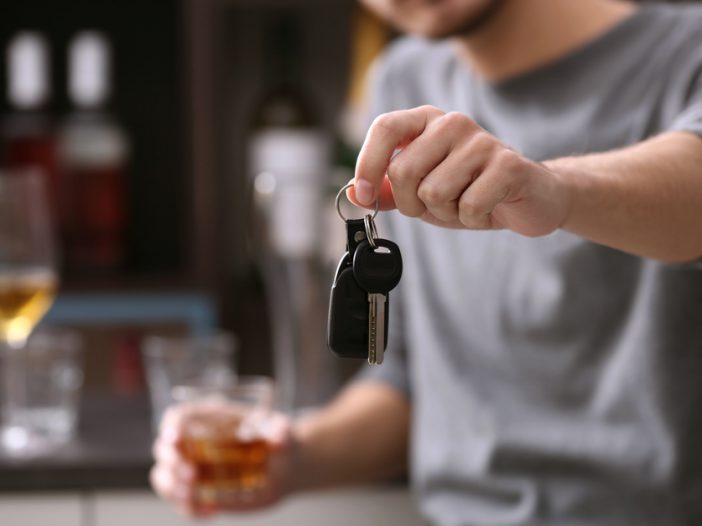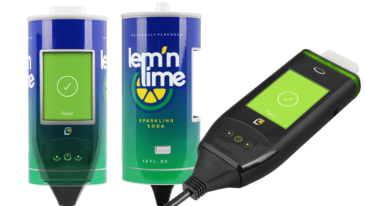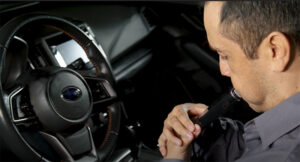
We’ve been taught from a young age, the dangers of driving while under the influence of alcohol. Just saying the words ‘drunk driving’ will probably conjure images of a swerving car, flashing police lights, and more dismally, fatal accidents. And it’s true, alcohol impairs reflexes and impulsivity—two cognitive functions necessary for driving safely. Additionally, alcohol disassociates consequences with action—it’s why people are more confident after a few alcoholic beverages.
The question is to what degree does alcohol have this effect? How does alcohol affect driving ability, and why is the legal blood alcohol concentration (BAC) what it is? To understand these questions, we’re going to have to dig into alcohol’s effect on the body and the brain. Being aware of these effects can help you prevent a DUI arrest and avoid installing a car breathalyzer in your vehicle.
What is Alcohol and What Does it do to the Body
Without diving too far into a chemistry lecture, let’s set up the molecule: C2H6O, or more commonly known as ethanol. When you consume ethanol, it flows through your digestive tract, much like any other consumed food or liquid. At the end of the stomach, there’s what’s known as the pyloric sphincter; this is the ‘pressure release valve’ of the gut. It determines when to open and close and how much partially digested food to let through to the small intestine.
If you’ve ever wondered why people suggest eating food before you drink alcohol, you can thank the pyloric sphincter for that.
- Alcohol Fact: Eating a large meal, especially one filled with fatty foods, can significantly reduce the peak BAC spike in your bloodstream. Some estimates point to a reduction of 50% versus drinking alcohol when you’re hungry and haven’t eaten.
Once past the gut, the alcohol travels through the small intestine where it is absorbed past the intestinal wall and into the bloodstream. From there, your blood takes the alcohol everywhere. If you’ve ever experienced a flushed sensation when drinking, or if your skin turns red, it’s because the alcohol is flowing through your circulatory system.
Next Stop: The Brain
Alcohol gets a free ride throughout your body, stressing your liver, causing your veins to surface and make you feel warmer, and of course, affecting your brain. Understanding what it does to the brain will help answer the question: how does the consumption of alcohol affect driving?
The blood-brain barrier is a thin membrane that allows capillaries (or tiny blood vessels) to bring blood to the brain and spinal cord while filtering out any foreign substances. Unfortunately, ethanol moves right past the barrier without filtration. Here, alcohol is able to affect neurotransmitters which control our mood, personality, and our behavior.
Alcohol Made Me Do It!
Ethanol is a depressant, which means it acts on inhibitory neurotransmitters, reducing the person’s energy levels and bringing everything to a calm state. It slows your heart rate and respiratory. However, that’s not all alcohol does. It also suppresses glutamate, which causes a bit of a traffic jam on your neural highways—thus, movement, speech, hearing, and sight become more affected the more alcohol in your system.
But if alcohol just made you calmer and sleepier, why would people do such reckless things on alcohol? Aha! In comes the twist: alcohol is dopaminergic. Drinking alcohol floods the reward and motivation systems with dopamine, making people think they’re on top of the world and motivated to prove it. This twist accounts for many things:
- The increased confidence levels (and over-confident activities that lead to injury)
- Why people consider drinking to be a ‘fun’ activity
- How alcohol is considered a social drug
- Why alcohol can be so addictive (it directly targets the reward system)
When people do something they regret, they often want to blame it on the alcohol. While this doesn’t hold in court, it is important to understand how people can act dramatically different under the effects of alcohol.
- Alcohol Fact: Research shows that the dopaminergic effect of alcohol is more impactful on men than women. Perhaps that’s why men are twice as likely to develop alcoholism.
Parts of the Brain that Are Affected
At this point, you might be starting to understand why alcohol and two-ton metal objects moving 70 mph (that’s 100 feet per second!) don’t mix. But before we jump into specifics about how alcohol affects your driving, let’s first see exactly which parts of the brain are targeted by alcohol’s various effects.
- Cerebral cortex – The cerebral cortex is where thought and logic take place. It’s also thought to be where the origin of consciousness is centered. When alcohol affects the cerebral cortex, the most significant effect is how a person’s inhibition declines. This makes it difficult to think clearly or rationally, making irrational ideas more likely to result.
- Medulla – The medulla is what controls the automatic regulatory responses within the body. Things like breathing or regulating body temperature or even controlling the beating of your heart can’t be conscious thoughts. If they were, we’d never have time to think about anything else. When alcohol affects these automatic functions, the end result is drowsiness in both mental and physical aspects.
- Cerebellum – The cerebellum controls things like balance and movement. Thus, that classic staggering you’ve seen with drunks is a result of an impaired cerebellum.
- Hypothalamus and pituitary glands – These glands regulate and release hormones throughout the body. While your body is under the influence of alcohol, the hormones affected involve stress, fear, and testosterone.
Put all this information together and you get the behavior, mood, and personality of someone drunk. Stumbling over their words. Tripping over their feet. And when behind the wheel, swerving the car back and forth, unable to drive with full control.
How Does Alcohol Affect Driving Ability
Now that we understand how alcohol affects the body and the mind, it’s pretty clear why such stringent DUI laws exist. When someone is intoxicated, they’re more confident and likelier to think that they can drive well enough to make it home safe. However, this is an inflated sense of confidence brought on by the same reaction that is causing loss of balance, impaired vision, drowsiness, and slowed reaction times.
The primary side-effects that directly result in worse driving performance include:
- Reduced concentration – When you’re driving, you’re doing many things at once. Your brain is consistently comparing your own speed with the cars around you. Your eyes, feet, and hands are working in unison. You’re checking your mirrors and updating your spatial awareness. And you’re on the lookout for bikers, pedestrians, stoplights, streetlights, and other signs that inform you of the proper driving protocol. All this takes incredible concentration and focus, even if it feels like you can do it in your sleep. After consuming alcohol, this normal level of concentration is reduced, making accidents likelier to occur.
- Lack of coordination – Do you remember when you were first learning to drive? Changing lanes required you to check your mirrors, assess your surroundings, put on your blinker, keep your eyes on the car in front of you, and speed up or slow down to navigate your way. Phew! While driving quickly becomes second nature, this only applies to when you’re sober. Drinking alcohol affects the cerebellum, which disrupts your coordination, causing impaired driving.
- Impaired vision – Most DUIs happen at night, and alcohol directly worsens night vision. Ethanol disrupts the thin outer layer of the eyeball, causing the aqueous gel to evaporate. When this happens, your vision and image quality is disturbed, making it harder to see when it’s dark out.
- Decreased reaction time – Safe driving requires you to be alert and vigilant. Imagine a dog suddenly sprinting out into the street. Usually, if the driver is alert, they’ll have enough time to slam on their brakes and stop before hitting the dog. The problem is, the person behind them also has to slam on their brakes to avoid hitting the car in front. This chain reaction can all be disrupted by one person who is driving while intoxicated and has decreased reaction times.
- Inhibited judgment – When you beat a yellow light, it can sometimes feel like a small victory. Sober and alert, this mentality is fine. Drunk and overconfident, thinking you can outrace a yellow light can lead to speeding through an intersection. This type of inhibited judgment is what will often lead to police arrests and possible crashes.
How Much Alcohol is Too Much to Drive
The legal limit to drive is 0.08 BAC. But at this point, how impaired are you? And what does that entail?
- 0.01 to 0.04 BAC – Although the effects of alcohol in the blood are immediate, having a BAC of 0.01 to 0.04 will have negligible effects on serious decision-making skills.
- 0.05 to 0.08 BAC – Typically equivalent to 2-4 drinks depending on your body type, this amount of alcohol is enough to put you at the limit of being able to drive. This blood alcohol content is associated with feelings of wellbeing, relaxation, and confidence.
- 0.09 to 0.15 BAC – Slurring speech and incoordination arise at these levels. It is unsafe to drive at this point, and nausea and vomiting may occur.
- 0.16 to 0.20 BAC – Serious impairment of judgment. This much alcohol puts a person in a risky mental state.
- 0.21 to 0.30 BAC – Considered “blacked-out” when the person can no longer walk without assistance, and any more could be considered dangerous, even lethal.
Above 0.30 BAC and the person will likely need to be hospitalized. This typically happens when a person in a dissociated, drunken state decides to chug more alcohol. When this happens, even after they’ve stopped drinking, their blood alcohol content continues to spike higher and higher until passing out.
- Alcohol Fact: Be wary of alcohol tolerance. The more you drink, the higher the blood alcohol content you need in order to feel the same effects. Two people of the same body type could each have five drinks in two hours. They could have the same 0.12 BAC, but one is “significantly drunker” than the other, due to alcohol tolerance. Despite feeling the effects differently, both would still be over the legal limit to drive.
Factors that Affect BAC
The blood alcohol concentration refers to how much of your blood consists of alcohol. If you have a 0.15 BAC, that means for every 1,000 milliliters of blood there are 1.5 milliliters of alcohol. For this alcohol to get into your bloodstream, it needs to be digested and absorbed through the small intestine. Thus, different factors are going to affect how your BAC level increases per drink.
- Body size and gender – If you have a smaller body type and drink the same amount of alcohol as someone with a larger body type, you’re going to become intoxicated quicker. There’s physically less blood in a smaller person, so the ratio of alcohol to blood is going to be higher. Gender also tends to play a role in this; men can generally drink more alcohol and have a lower BAC than women.
- Metabolism – Because alcohol has to pass the gut and be absorbed into the bloodstream, the rate of your metabolism plays a role in how quickly your BAC spikes. A faster metabolism means the alcohol is quickly shooting into your blood.
- Concentration of alcohol in mixed drinks – A beer is fairly standard wherever you go. Although there are beers upwards of 10-12% abv, the standard is around 4-7% alcohol per volume. A full beer is then equivalent to one shot of hard liquor. However, when ordering at bars and clubs, mixed drinks will often be eyeballed in terms of how much hard alcohol is in them. When they’re made especially strong, this can cause a quick spike in BAC.
When out drinking, always set a personal limit and keep track of how many drinks you’ve had to avoid going overboard.
- Alcohol Fact: Although eating a large meal ahead of time will slow the absorption of alcohol into the bloodstream, there’s nothing to be done once the alcohol is in the blood. Meaning, you can’t eat a big meal after drinking to reverse alcohol’s effects.
Being Convicted of a DUI
When convicted of driving while under the influence, this is typically charged as a misdemeanor. The consequences vary from jail time, fines, suspended or revoked driver’s license, installment of an ignition interlock device, and more.
Repeat offenses stack up the consequences, and often a third-time offense will be considered a felony with years of prison time associated with the conviction.
Breathalyzers and Ignition Interlock Devices
To measure the alcohol in a person’s body, they can blow into a breathalyzer which reads the amount of ethanol present in your breath. These can determine an accurate measurement of the alcohol in your blood.
Ignition interlock devices can be installed into a vehicle’s engine to prevent drunk driving. The driver has to blow into a breathalyzer for the IID to allow the motor vehicle to start.
Alcohol and Driving Don’t Mix
Hopefully knowing the effects of alcohol on both the body and the brain help to deter you from drinking and driving. Remember that alcohol creates the perfect concoction of impairment that turns driving into a potentially lethal task, putting everyone around you at risk. Always keep track of your alcohol consumption, and if you feel impaired, call a cab and keep your driving record clean. A DUI is never worth it.
Sources:
https://wrightvisioncenter.com/blog/alcohols-effects-on-night-vision/


